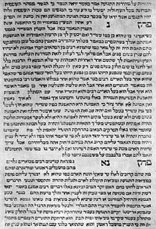Reflections
Master of Repentance: Rabbenu Yona of Gerona
One of the greatest giants in Torah and Mussar during the Middle Ages, and author of the Sefer ‘Shaarei Teshuva’, a phenomenal work designed to arouse the soul to repentance
Rabbenu Yonah was an undisputed giant in Torah and piety, and even his rivals admitted to his greatness and accorded him great respect. Because of his immense piety and fear of Heaven he was often described as ‘the pious one’, or ‘the holy one’.
Rabbenu Yonah spent his days disseminating Torah and he founded several Yeshivos. From amongst his illustrious students, the most outstanding was Rav Shlomo ben Avraham (the Rashba). Of all the Chachamim of the generation, he held the closest relationship with his cousin – the Ramban (the mother of the Ramban was Rabbenu Yonah’s father’s sister). He even married off his daughter to the son of the Ramban, Rav Shlomo. When Rabbenu Yonah passed away his daughter was expecting a child, and when she gave birth to a son the Ramban said: ‘Even though you would have called the child after me, I want you to call him Yonah after his mother’s father, so that he should grow great in Torah and fear of Heaven.’
 |
|
| More Nevuchim-book cover | |
Rabbenu Yona established his Yeshiva in Barcelona, and with every Halacha that he expounded he mentioned the Rambam’s name with reverence. After three years in Barcelona he set out to fulfil his vow: to ascend to the holy Land and prostrate himself before the grave of the Rambam. However, as he passed through the city of Toledo, the members of the community pressed him to stay there a while and teach them Torah. Rabbenu Yona acceded to their request and established a large Yeshiva there, and postponed the implementation of his vow. Alas he was unable to fulfil this promise since he passed away suddenly, on the 28th of Cheshvan 5024 (1264).
He left behind a treasure-trove of holy writings, which are studied in depth to this day. Many are no longer in our hands, but references to them are made in a number of commentaries of the Rishonim. Amongst the Sefarim we are privileged to have in our possession today are: a commentary on the Tractate Avos, printed in the Shas Vilna; ‘Sam haChaim’ on Tractate Sanhedrin; ‘Aliyos d’Rabenu Yona’ on Tractate Bava Basra. The name of this Sefer is derived from the fact that at the end of each discussion Rabbenu Yona writes “Mah she’ala b’yadenu”. On Tractate Brachos, there is a commentary on the Rif (Rav Yitzchak Alfassi – a Halacha Sefer) which was compiled by his students, and given the name ‘Talmidei Rabbenu Yona’.
Of all his impressive compilations, the Sefer that gained most fame was the Mussar work “Shaarei Teshuva” (Gates of Repentence), delineating the gateways to arouse a person to fear of Heaven and a return to his Creator in true repentance. It is an accepted component of Mussar study in all Yeshivos, particularly during the month of Elul as preparation for the Days of Awe. The Sefer is divided into four ‘Gates’ – The First Gate discusses the pathways of repentance that a person must tread to ensure his repentance is complete and long-lasting. In the ‘Second Gate’ he defines various aspects that can arouse a person’s heart to return to his Creator. The ‘Third Gate’ instructs a person to inspect all his deeds so as to ensure he won’t inadvertently sin due to lack of knowledge or insufficient attention. Here Rabbenu Yona details many positive and negative commandments which are frequently transgressed. He also explains the reasons for the widespread negligence in these areas, and outlines the essence of the sin and the extent of the ‘stain’ that sullies the soul of the transgressor. This section could constitute an entire Sefer in and of itself. Finally, the ‘Fourth Gate’ discusses methods of atonement for those whose souls are sullied by serious sin. This section is divided according to the severity of the sin and its punishment.
It is told in the name of Rabbi Akiva Eger, that the teachings in ‘Shaarei Teshuva’ deeply obligate us since Rabbenu Yona was an Halachic authority (Posek) and his words are quoted in the Shulchan Aruch. If so, his rebukes are also of Halachic potency! This compilation was part of a larger Sefer called ‘Shaarei Tzedek’, in which there was ‘Shaarei Torah’, ‘Shaarei Tefillah’, ‘Shaarei Avoda’ and ‘Shaarei Sinah’; however we were not privileged to enjoy their contents as they are not in our hands today. Together with the Sefer ‘Shaarei Teshuva’ other Sefarim were also printed – small in number but immeasurably great in value: ‘Sefer haYirah’, ‘Igeres haTeshuva’, and ‘Yesod haTeshuva’.






